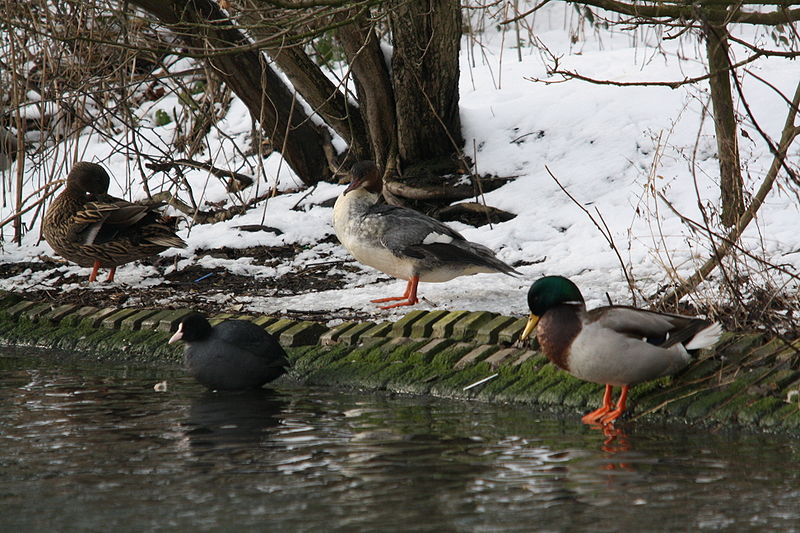Interactions
 Common
mergansers are very important predators in aquatic ecosystems.
They feed on small fish most of the time including
small mouth bass, perch,
large mouth bass,
trout, and
salmon. Common mergansers thin the populations of
fish which brings the ponds and lakes below their carrying
capacity. This allows the surviving fish to grow and thrive.
When fish are in scarce supply, these birds will resort to
feeding on mollusks, crustacean, aquatic and terrestrial worms,
frogs, and sometimes even small mammals and birds. On rare
occasions, common mergansers have been reported to feed on some
aquatic plant life.
Common
mergansers are very important predators in aquatic ecosystems.
They feed on small fish most of the time including
small mouth bass, perch,
large mouth bass,
trout, and
salmon. Common mergansers thin the populations of
fish which brings the ponds and lakes below their carrying
capacity. This allows the surviving fish to grow and thrive.
When fish are in scarce supply, these birds will resort to
feeding on mollusks, crustacean, aquatic and terrestrial worms,
frogs, and sometimes even small mammals and birds. On rare
occasions, common mergansers have been reported to feed on some
aquatic plant life. Common mergansers share their habitats with many other creatures. Some birds that inhabit the same areas as common mergansers include common loons, common goldeneyes, and their close relatives, the red-breasted merganser and hooded mergansers. Common mergansers also share habitats with many different species of fish, amphibians, mammals, and invertebrates.
 Although
common mergansers are considered the top predators in aquatic
food chains, there is still a slight risk of predation. There is
a very small predation risk and the survival rate of young
common mergansers is relatively high. Some animals that could be
a threat to the nest of common mergansers are red squirrels,
black bears, northern flickers, and American martens. Large
predatory fish, like the
northern pike, and predatory birds, including the
bald eagle, golden eagle, hawks, and some owls, may prey
upon weak immature common mergansers. Overall, the predation
rate of common mergansers is very low.
Although
common mergansers are considered the top predators in aquatic
food chains, there is still a slight risk of predation. There is
a very small predation risk and the survival rate of young
common mergansers is relatively high. Some animals that could be
a threat to the nest of common mergansers are red squirrels,
black bears, northern flickers, and American martens. Large
predatory fish, like the
northern pike, and predatory birds, including the
bald eagle, golden eagle, hawks, and some owls, may prey
upon weak immature common mergansers. Overall, the predation
rate of common mergansers is very low.Egg-dumping or brood parasitism, happens quiet often between common mergansers and other closely related birds including the hooded merganser and common goldeneye. One bird will lay their eggs in another females nest creating clutches with up to 19 eggs. This does not have an overly negative impact on the birds.
Common mergansers have no negative affects to humans. There are some positive affects that common mergansers have on humans. Common mergansers help limit the fish populations in ponds and lakes allowing the surviving fish to have less competition for natural resources. Less competition means that more fish can reach the legal size for fishermen. The fishermen indirectly benefits from this form of natural population control.
Common mergansers are not thought to be threatened
at this time. They are still fairly common in both the Nearctic and
Paleartic regions. The main limiting factor on the common merganser
population is the scarcity of nesting sites. Human development has forced
common mergansers to move their nesting sites further south. However, nest
boxes have been installed in various locations to provide more suitable
nesting sites.
Questions? Comments? Concerns? contact me at bales.aman@students.uwlax.edu
For more interesting organisms visit multiplerganisms.net